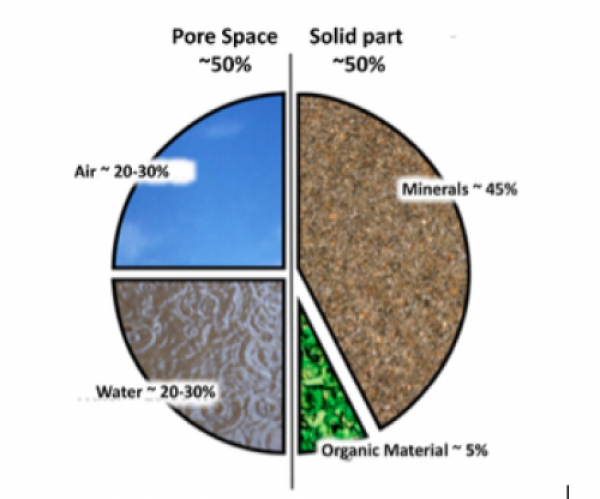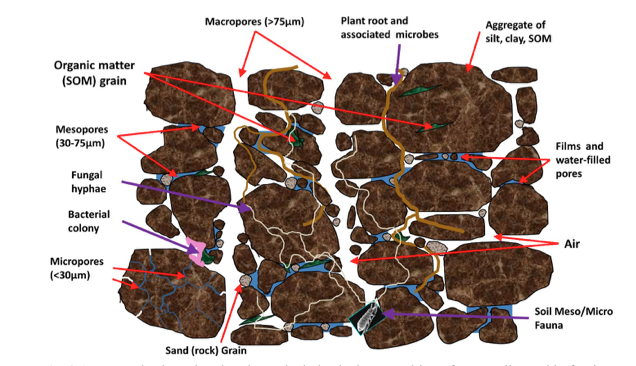What is Soil?
We may be used to referring to soil as “dirt”, as in “my keys fell in the dirt somewhere” or “after planting the garden we had dirt all over our hands” but the way in which soil supports food production far more complex than a smear of clay on our hands. One way to define this difference in perspective is to think about the biological and chemical complexity in soil, and the fact that soils are not just brown, powdery handfuls of dirt but occupy a grand scale in the natural systems that underlie food systems. Soil is the "skin of the earth", layers that ascend from bedrock and supply water and nutrients to the fields and forests that make up the terrestrial biosphere. Soils are ecosystems in their own right, within mineral layers that form part of the earth’s surface. Soils can be as shallow as ten centimeters and as deep as many tens of meters.
An interesting exercise is to think of a single term or concept that describes how soils work and what they are. For example, if we were seeking an acronym to describe soil and market it as the marvelous thing that it is1 —and if we lacked time to think of a catchier name – we might think up the acronym “PaBAMOM” which nevertheless is a pretty good summary of what soil is: a “Porous and Biologically Active Mineral-Organic Matrix”. It’s a good summary because it defines the unique properties of soils (see Figure 5.1.1 below):
- Porous (full of open spaces or pores), at a range of pore sizes from well below a micron (10-6 m or 0.0001 cm) to many centimeters, and therefore able to store water and transmit it to deeper earth layers, and host organisms as diverse as bacteria, plant roots, and prairie dogs. This porosity arises not only from the inherent sizes of particles in soil but is also a result of soil organisms and roots that generate aggregation of the soil from clay and silt particles into crumbs and clods that may be familiar to from typical garden soil. This biologically generated aggregation is sometimes referred to as structure, which is seen in figure 5.1.1 as the overall arrangement of pores and aggregates, and in the notion that soil is a matrix (point five below). The ideas of aggregation and structure will be revisited in this module and in module 7.
- Soil is phenomenally biologically active and biologically diverse, especially in microbes, which makes it able to perform many useful functions. For example, soil microbes are able to "recycle" or decompose materials like wood, wheat straw, and bean roots into energy for themselves and other soil biotas; various other types of microbes also draw or fix nitrogen out of the air to feed plants, detoxify the soil from organic pollutants, or perform myriad other beneficial services -- and other not so beneficial processes such as diseases.
- Soil is mineral, formed from the breakdown and chemical processing of the earth’s rock crust into sand, silt, and clay, each with its own ability to store water based on the size of pores they create and unique chemical roles in further processing and breakdown of soil materials. Usually, the mineral part is most of the solid (non-pore) part of soil (Figure 5.1, top pie chart)
- Soil is also organic, containing bits of organic (carbon-containing) remnants of plants and animals, some of which become stabilized until they last hundreds and even thousands of years as part of the soil. In the current efforts to promote carbon sequestration to alleviate (mitigate) climate change, it is worth noting that the amount of carbon stored in these bits of soil organic matter globally easily exceeds the total carbon stock in all of the planet’s forests.
- Lastly, it is a matrix, which means that at least as important as the particles, aggregates, and pores of the soil are the organisms and processes that occur on and in these particles and pores (Fig. 3.1, bottom). This matrix hosts a highly complex ecosystem that winds its way through the millions of pores, roots, fungal hyphae, insects, and other organisms in soil. And here we are referring to the complex system concept we presented in module one: soil has many interacting parts with overlapping interactions, the ability to produce unexpectedly stable or unstable outcomes, and contains processes that can produce positive and negative feedbacks. One important example of this type of behavior is the range of soil productivity “behavior” of soils over time, including the ability of some soils to sustain moderate to high levels of productivity over years or decades (they resist change through processes of negative feedback), and then collapse in terms of food production as the interlocking, complex systems fueled by organic constituents and biological processes are dismantled (positive feedbacks operate to drive them towards degradation). Soils can then be similarly resilient in terms of remaining unproductive until the complex systems can be rebuilt through soil restoration practices.


So, soil is not dirt. It is porous and complex, it covers almost every land surface on the planet (ice caps, glaciers, and bare rock are exceptions), and it is a ubiquitous, critical resource that is heavily coupled to human societies for their food production and in need of protection. It’s not dirt, it’s a PaBAMOM!
1. We don’t have to do this marketing job (phew!) because the existence and value of soils are so often taken for granted. Recently, economists have been working on estimating the implicit worth of the services performed for society by a single hectare (100 m x 100 m) of soil, and the amounts can range into tens of thousands of dollars per year depending on soils’ properties and the way they are used.
